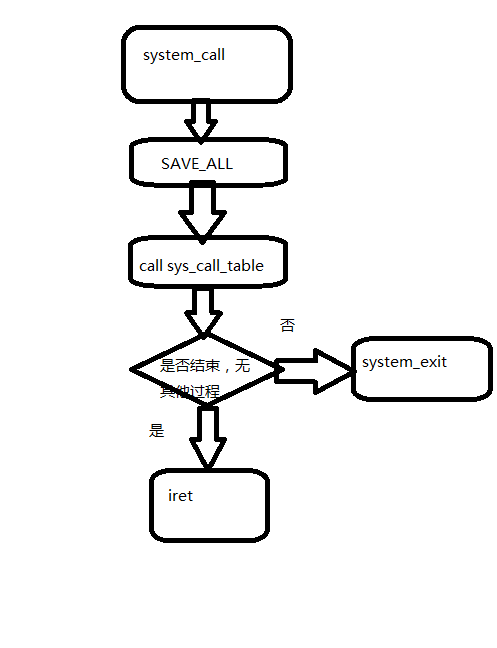lab5:分析system_call中断处理过程
2016-03-27 21:43
447 查看
李俊锋 + 原创作品转载请注明出处 + 《Linux内核分析》MOOC课程http://mooc.study.163.com/course/USTC-1000029000
一.实验原理1.应用程序、封装例程、系统调用处理程序及系统调用服务例程之间的关系
ENTRY(system_call) RING0_INT_FRAME # can't unwind into user space anyway ASM_CLAC pushl_cfi %eax # save orig_eax SAVE_ALL GET_THREAD_INFO(%ebp) # system call tracing in operation / emulation testl $_TIF_WORK_SYSCALL_ENTRY,TI_flags(%ebp) jnz syscall_trace_entry cmpl $(NR_syscalls), %eax jae syscall_badsys syscall_call: call *sys_call_table(,%eax,4) syscall_after_call: movl %eax,PT_EAX(%esp) # store the return value syscall_exit: LOCKDEP_SYS_EXIT DISABLE_INTERRUPTS(CLBR_ANY) # make sure we don't miss an interrupt # setting need_resched or sigpending # between sampling and the iret TRACE_IRQS_OFF movl TI_flags(%ebp), %ecx testl $_TIF_ALLWORK_MASK, %ecx # current->work jne syscall_exit_work restore_all: TRACE_IRQS_IRET restore_all_notrace: #ifdef CONFIG_X86_ESPFIX32 movl PT_EFLAGS(%esp), %eax # mix EFLAGS, SS and CS # Warning: PT_OLDSS(%esp) contains the wrong/random values if we # are returning to the kernel. # See comments in process.c:copy_thread() for details. movb PT_OLDSS(%esp), %ah movb PT_CS(%esp), %al andl $(X86_EFLAGS_VM | (SEGMENT_TI_MASK << 8) | SEGMENT_RPL_MASK), %eax cmpl $((SEGMENT_LDT << 8) | USER_RPL), %eax CFI_REMEMBER_STATE je ldt_ss # returning to user-space with LDT SS #endif restore_nocheck: RESTORE_REGS 4 # skip orig_eax/error_code irq_return: INTERRUPT_RETURN .section .fixup,"ax" ENTRY(iret_exc) pushl $0 # no error code pushl $do_iret_error jmp error_code .previous _ASM_EXTABLE(irq_return,iret_exc) #ifdef CONFIG_X86_ESPFIX32 CFI_RESTORE_STATE ldt_ss: #ifdef CONFIG_PARAVIRT /* * The kernel can't run on a non-flat stack if paravirt mode * is active. Rather than try to fixup the high bits of * ESP, bypass this code entirely. This may break DOSemu * and/or Wine support in a paravirt VM, although the option * is still available to implement the setting of the high * 16-bits in the INTERRUPT_RETURN paravirt-op. */ cmpl $0, pv_info+PARAVIRT_enabled jne restore_nocheck #endif /* * Setup and switch to ESPFIX stack * * We're returning to userspace with a 16 bit stack. The CPU will not * restore the high word of ESP for us on executing iret... This is an * "official" bug of all the x86-compatible CPUs, which we can work * around to make dosemu and wine happy. We do this by preloading the * high word of ESP with the high word of the userspace ESP while * compensating for the offset by changing to the ESPFIX segment with * a base address that matches for the difference. */ #define GDT_ESPFIX_SS PER_CPU_VAR(gdt_page) + (GDT_ENTRY_ESPFIX_SS * 8) mov %esp, %edx /* load kernel esp */ mov PT_OLDESP(%esp), %eax /* load userspace esp */ mov %dx, %ax /* eax: new kernel esp */ sub %eax, %edx /* offset (low word is 0) */ shr $16, %edx mov %dl, GDT_ESPFIX_SS + 4 /* bits 16..23 */ mov %dh, GDT_ESPFIX_SS + 7 /* bits 24..31 */ pushl_cfi $__ESPFIX_SS pushl_cfi %eax /* new kernel esp */ /* Disable interrupts, but do not irqtrace this section: we * will soon execute iret and the tracer was already set to * the irqstate after the iret */ DISABLE_INTERRUPTS(CLBR_EAX) lss (%esp), %esp /* switch to espfix segment */ CFI_ADJUST_CFA_OFFSET -8 jmp restore_nocheck #endif CFI_ENDPROC ENDPROC(system_call) entry_call
View Code
[b]4.[b][b][b][b]system_call精简代码如下所示:[/b][/b][/b][/b]
ENTRY(system_call) SAVE_ALL #保存现场 syscall_call: call *sys_call_table(,%eax,4) #中断向量表,查阅中断向量表,调用系统调用 syscall_after_call: movl %eax,PT_EAX(%esp) # 存储返回值 syscall_exit: LOCKDEP_SYS_EXIT DISABLE_INTERRUPTS(CLBR_ANY) # 确保不会错过中断 restore_all: TRACE_IRQS_IRET irq_return: INTERRUPT_RETURN ENDPROC(system_call)
5.system_call流程图如下所示:

个人总结:本次实验的难度明显比之前的实验要难,而且做实验时,由于实验楼环境比较卡,因此配置实验环境可花了不少时间,希望下次实验不要遇到这么多麻烦(*^__^*)
相关文章推荐
- BZOJ-2659 算不出的算式 找规律找规律找规律(说三遍)
- OpenGL顶点数据传输速度优化
- Linear Regression with one variable单参数线性回归
- HDU 5640 King's Cake
- Shiro入门7:修改自定义realm支持散列MD5密码对比
- Java语法01
- 学习总结
- SSH网上商城环境搭建
- Activiti系列(四)——设计指定Assignee+审批
- 向上转型和向下转型
- PAT-1012. 数字分类 (20)
- hdu 5651(逆元+排列组合)
- 深入理解JVM之一:Java内存区域
- 指针和引用
- 共享内存相关系统调用
- mysql实现主从复制
- CCF 无线网络
- BZOJ 1205: [HNOI2005]星际贸易
- String,StringBuffer与StringBuilder的区别
- hdoj 1106 排序
